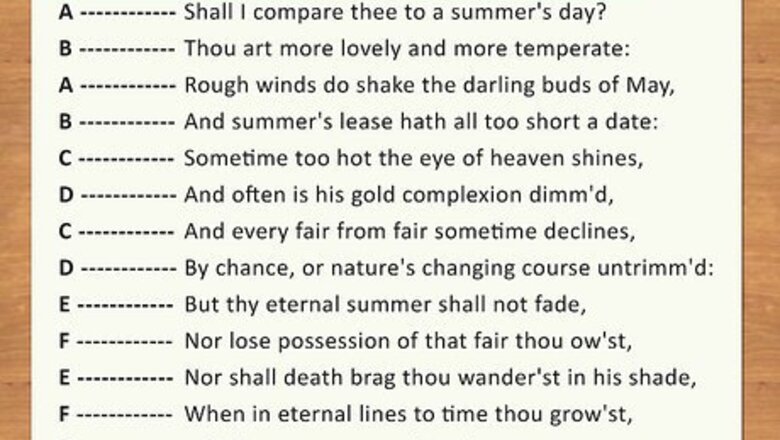
views
Writing a Shakespearean Sonnet
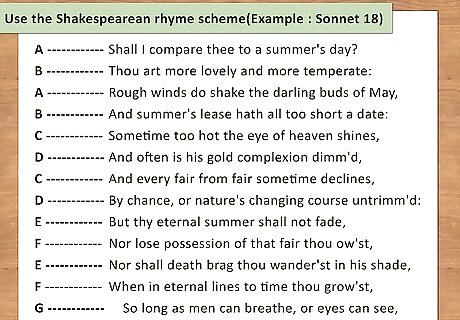
Use the Shakespearean rhyme scheme. The Shakespearean sonnet is a good place to start if you're a novice sonneteer because it has the most regular and straightforward rhyme scheme and structure. The rhyme scheme of a Shakespearean sonnet always follows this pattern: ABABCDCDEFEFGG These letters represent the sound that appears at the end of each line. So, following this pattern of alternating rhymes, we find that the last words of the first and third lines must rhyme; the second and fourth; the fifth and seventh; the sixth and eighth; and so on, ending in a final rhyming couplet.
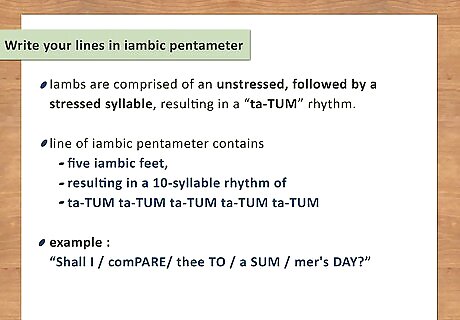
Write your lines in iambic pentameter. Iambic pentameter is a type of poetic meter, meaning that it's a way of measuring out the rhythm of a line. Iambic pentameter is a very regular meter and is one of the most common meters in English-language poetry. “Pentameter” derives from the Greek word pente (meaning five), and thus has five poetic "feet." Each foot is a unit of two syllables; thus, there are ten syllables in a line of pentameter. “Iambic” means that each foot is an “iamb.” Iambs are comprised of an unstressed, followed by a stressed syllable, resulting in a “ta-TUM” rhythm. The word “hel-LO” is an example of an iambic foot. So a line of iambic pentameter is a line of five iambic feet, resulting in a 10-syllable rhythm of ta-TUM ta-TUM ta-TUM ta-TUM ta-TUM. An example of a line of iambic pentameter is “Shall I / comPARE/ thee TO / a SUM / mer's DAY?” (from Shakespeare's “Sonnet 18”)
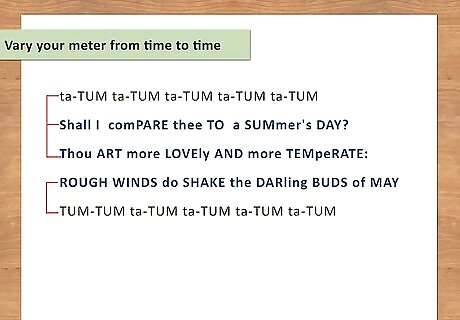
Vary your meter from time to time. Although the majority of the lines in a Shakespearean sonnet should be written in iambic pentameter, the rhythm can get plodding and predictable if you use it exclusively. By varying the stress pattern slightly at key moments, you can break up the pattern and make the poem more aurally interesting for the reader, and also use the variation to draw attention to key phrases in your poem. For example, the third line of Shakespeare's “Sonnet 18” begins with a spondee, meaning two stressed syllables in a row: TUM-TUM After two lines of perfect iambic pentameter, he wrote: “ROUGH WINDS / do SHAKE / the DAR / ling BUDS / of MAY” This both breaks up the rhythm for a little variation and draws attention to the roughness of the rough winds being described.
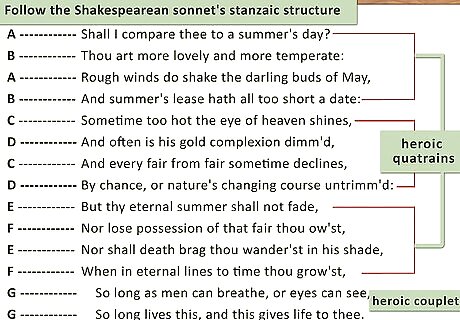
Follow the Shakespearean sonnet's stanzaic structure. A Shakespearean sonnet is composed of three heroic quatrains and a heroic couplet. A heroic quatrain is a group of four lines of iambic pentameter in an ABAB rhyme scheme; a heroic couplet is a group of two lines of iambic pentameter in an AA rhyme scheme. In a Shakespearean sonnet, the three heroic quatrains are the “ABAB CDCD EFEF” portion of the rhyme scheme The heroic couplet is the “GG” closing. You can separate these stanzas with blank lines, or leave them all together in an unbroken poem, but the sonnet should move as a function of these discrete stanzas.
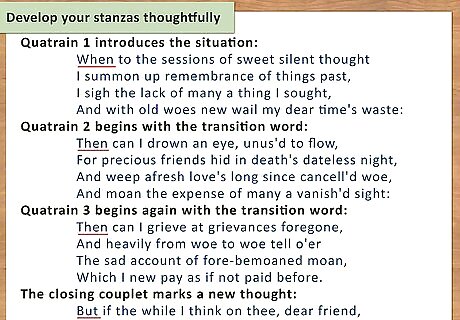
Develop your stanzas thoughtfully. Although your poem should have a single focus, each stanza of the sonnet should develop the idea further. Think of each quatrain as a little thought bubble, like a paragraph, in which you explore an element of the subject of your poem. Each quatrain should build toward the final couplet, where you will have a turn, or a volta. The turn, which occurs in the 13th line of the Shakespearean sonnet, offers a resolution or insight into to the problem developed in the first three quatrains. It may help to examine an example, such as Shakespeare's "Sonnet 30": Quatrain 1 introduces the situation: Sometimes, when I think about the past, I regret the things and people I've lost. This quatrain uses legal terminology to get the point across: sessions and summons. Quatrain 2 begins with the transition word “Then,” suggesting that it is connected to Quatrain 1, but moving on to a further development of the idea: when I'm in a nostalgic mood like that, I can cry freely about friends who have passed away or been otherwise lost to me. In this quatrain, he uses the language of commerce to develop the idea: cancelled woe and expenses. Quatrain 3 begins again with the transition word “Then,” and further develops the idea using the language of commerce (accounts, payment): Not only do I cry, but I cry heavily, as though I've never mourned this loss before. The closing couplet marks a turn with the word “But,” which suggests that this is not a continuation (like “Then”), but a new thought. There is no resolution to the problem of mourning here, but there is insight into grief and loss: to think of your memory is wonderful enough to make me feel as though I never lost anything. Again, this couplet continues the imagery of commerce (losses).

Choose your subject matter carefully. Although you can write a Shakespearean sonnet about anything, they are traditionally love poems; you might keep this in mind if you want to write a purely traditional sonnet. Note too that because of the top-heavy stanzaic structure of the Shakespearean sonnet, the form does not lend itself well to highly complex or abstract subjects. The turn and resolution must come quickly, in the final two lines, so choose a subject that can be easily resolved with a witty closing couplet. If you have a more contemplative subject, a Petrarchan sonnet may lend itself better to what you want to say.
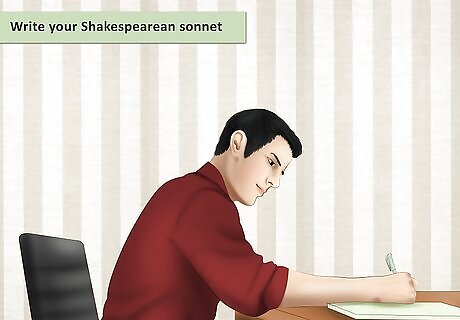
Write your Shakespearean sonnet. Remember to follow the rhyme scheme, to write in iambic pentameter while inserting metrical variation from time to time, and to develop the subject matter through each of the three heroic quatrains, before offering a turn and resolution/insight in the closing heroic couplet. Use a rhyming dictionary if you have trouble finding rhymes for the ends of your lines.
Writing a Petrarchan Sonnet
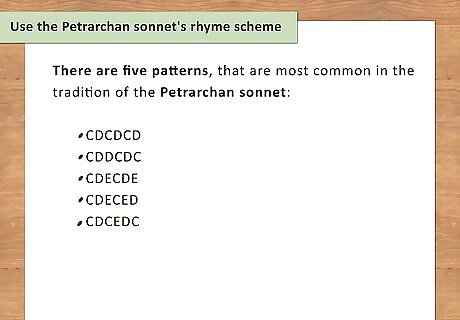
Use the Petrarchan sonnet's rhyme scheme. While the Shakespearean sonnet always has the exact same rhyme scheme, the Petrarchan sonnet does not have a single pattern. Though the first eight lines (the octave) always follow a rhyme scheme of ABBAABBA, the closing six lines (the sestet) have some variation. There are five patterns, though, that are most common in the tradition of the Petrarchan sonnet: CDCDCD CDDCDC CDECDE CDECED CDCEDC
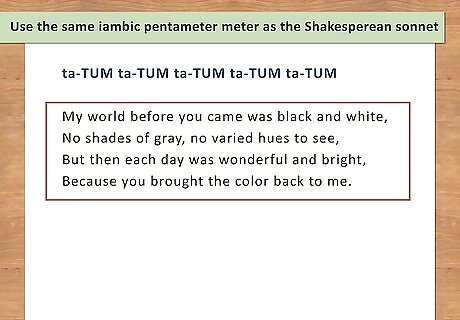
Use the same iambic pentameter meter as the Shakesperean sonnet. All lines should follow the “ta-TUM ta-TUM ta-TUM ta-TUM ta-TUM” pattern, but remember to insert metrical variation from time to time to enliven the rhythm and draw attention to key phrases.
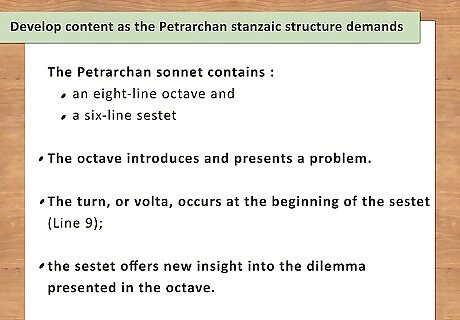
Develop content as the Petrarchan stanzaic structure demands. Whereas the Shakespearean sonnet has a top-heavy structure of 3 quatrains and a couplet, the Petrarchan sonnet is a little more balanced, using an eight-line octave and a six-line sestet to develop the poem's subject. As such, it's well-suited to complex issues that require a lot of room to resolve, rather than the easy, witty resolution of a Shakespearean sonnet's closing couplet. The octave introduces and presents a problem. The turn, or volta, occurs at the beginning of the sestet (Line 9); the sestet offers new insight into the dilemma presented in the octave. Consider William Wordsworth's “Nuns Fret Not at Their Convent's Narrow Room” as an example for analysis: The octave progresses through a series of examples of creatures and people who are not bothered by restricted spaces. The progression moves from the most revered element of society to the lowliest: from nuns, to hermits, to scholars, to manual laborers, to insects. The turn in this sonnet actually occurs a line early, at the end of the octave. Although this is not purely traditional, poets throughout history have experimented with the form and manipulated it to their needs. You should feel free to do the same. In Line 8, “In truth” marks the volta or turn; now, Wordsworth will give more insight into the idea of being comfortable in restrained spaces. The sestet suggests that the formal restrictions of the sonnet — with its rhyme scheme, iambic pentameter restriction, and strict octave-sestet structure — is not a prison, but a way for the poet to free himself and “find solace.” He hopes that the reader, too, shares this feeling. The sestet provides insight that allows us to consider all the people and things in the octave with a deeper understanding.
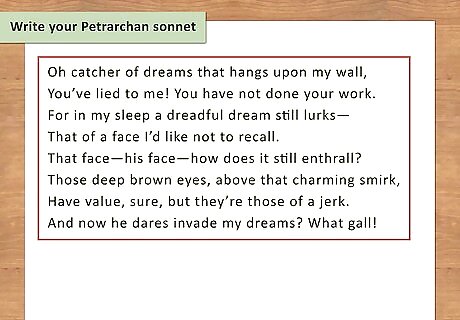
Write your Petrarchan sonnet. Just as you did with the Shakesperean sonnet, keep in mind the Petrarchan rhyme scheme and stanza structure, and remember to write in iambic pentameter with occasional metrical variation. Note that, just as Wordsworth did in "Nuns Fret Not at Their Convent's Narrow Cell" by moving the volta up from the traditional ninth line to the eighth, you can manipulate the form to meet the needs of the poem you're trying to write. The sonnet has changed in many ways throughout history, so make it work for you. An example of a Petrarchan sonnet that beautifully manipulates the form to make a point is Edna St. Vincent Millay's "I Will Put Chaos into Fourteen Lines," which is a sonnet about writing a sonnet. Millay employees the Petrarchan rhyme scheme and meter, but interrupts her lines with enjambments (splitting the line in the middle of a sentence or clause) and occasional disruptions of the meter to emphasize her struggle with the sonnet form itself.
Experimenting with Less Common Sonnet Forms

Explore proportion through the curtal sonnet. This form was developed by Gerard Manley Hopkins, and takes its name from the “curtailed” nature of its manipulation of the Petrarchan sonnet form. Mathematically, the curtal sonnet is precisely 3/4 of a Petrarchan sonnet, shrunk proportionally. By experimenting with this form, you can explore how the ratio of the Petrarchan sonnet works within a more concise space. Consider whether or not you think anything changes in the relationship between the two halves of the poem when you transition from the full Petrarchan structure to the condensed curtal structure. The curtal sonnet is composed of a sestet with a rhyme scheme of ABCABC and a quintet (five line stanza) of a rhyme scheme of either DCBDC or DBCDC. Though it appears to be 11 lines, which is a little more than 3/4 of the normal 14-line Petrarchan sonnet, it is actually 10.5 lines; this is because the final line of the curtal sonnet is half a line of iambic pentameter — sometimes even less. Other than the last line, the curtal sonnet is still written in iambic pentameter. Hopkins' “Pied Beauty” is a famous example of a curtal sonnet. Note that the final line, “Praise him” truncates the 11th line to the 3/4 proportion intended by Hopkins.
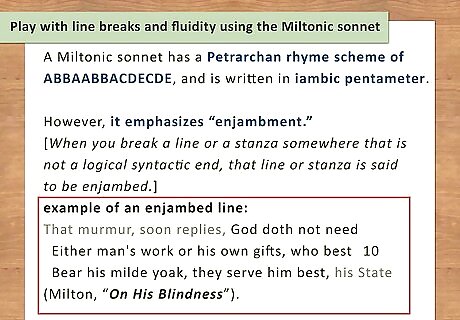
Play with line breaks and fluidity using the Miltonic sonnet. This form, developed by John Milton, also takes the Petrarchan sonnet as its basis, and is almost identical in form to it. However, the Petrarchan sonnet treats the octave and sestet as two discrete sections separated by a turn; Milton wanted to explore what happened to the Petrarchan sonnet when you rid the poem of all separations. A Miltonic sonnet has a Petrarchan rhyme scheme of ABBAABBACDECDE, and is written in iambic pentameter. However, it omits the turn/volta at the beginning of the sestet, and instead emphasizes “enjambment.” When you break a line or a stanza somewhere that is not a logical syntactic end (somewhere where you'd normally find a period, comma, or semicolon), that line or stanza is said to be enjambed. An example of an enjambed line is: “God doth not need / Either man's works or his own gifts: who best / Bear his mild yolk, / they serve him best” (Milton, “On His Blindness”). See Milton's “On His Blindness” for an example of a Miltonic sonnet. Note how it makes use of enjambment both in individual lines and in the melding together of the octave and sestet.
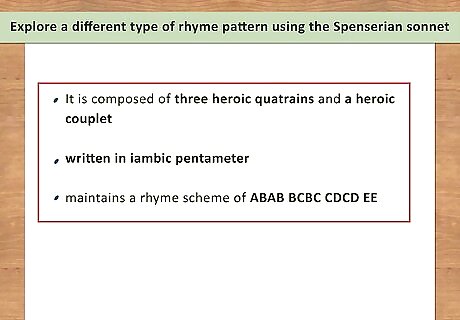
Explore a different type of rhyme pattern using the Spenserian sonnet. Whereas the curtal and Miltonic sonnets took the Petrarchan sonnet as their basis, the Spenserian sonnet, developed by Edmund Spenser, is modeled after the Shakespearean sonnet. However, it explores an interlocking rhyme scheme. It is composed of three heroic quatrains and a heroic couplet, just like the Shakespearean sonnet. Furthermore, it is also written in iambic pentameter. However, the rhyme scheme differs from the Shakespearean sonnet in that it is interlocking: The second rhyme sound from each quatrain becomes the first rhyme sound of the subsequent quatrain. This results in a rhyme scheme of ABAB BCBC CDCD EE. Contrast that against the rhyme scheme of the Shakespearean sonnet: ABAB CDCD EFEF GG. The interlocking rhyme scheme results in the three quatrains being closely linked aurally by the repeated rhyme sounds, especially in the transition between quatrains, when the second rhyme of one stanza is immediately repeated as the first rhyme of the next. Just as the Miltonic stanza explores the relationship between parts of the Petrarchan sonnet by using line breaks and enjambments, the Spenserian sonnet explores the relationship between parts of the Shakespearean sonnet by using interlocking rhyme patterns.

Explore shorter stanzas and different rhyme schemes using the terza rima sonnet. With the exception of the curtal sonnets, all of the sonnet forms we've looked at thus far make use of quatrains in their first section. The terza rima sonnet, though, is written using interlocking tercets, or stanzas of three lines. It is still written using iambic pentameter, and still has 14 lines. However, it has a rhyme scheme of ABA BCB CDC DAD AA. Note that the “A” rhyme from the opening tercet is repeated in the sandwiched ending of the fourth tercet, and also in the rhyme of the closing heroic couplet. Even more than the Spenserian sonnet, the terza rima sonnet asks you to consider the relationship between the stanzas in the poem, as developed not only through subject, but through sound. By splitting the first part of the poem into groups of three rather than four lines, it asks you to develop the ideas in each stanza more quickly and concisely. An example of a terza rima sonnet is Robert Frost's “Acquainted with the Night.”
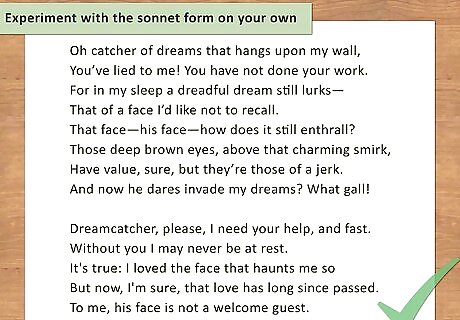
Experiment with the sonnet form on your own. As you can see from the variety of sonnet forms presented thus far, poets have taken liberties with the sonnet throughout its history. Though the form came to prominence with Petrarch, after whom the Petrarchan sonnet is named, it evolved greatly in the hands of British poets like Sir Thomas Wyatt, Henry Howard, Earl of Surrey, and, of course, Shakespeare, who brought the form to its greatest popularity. However, Hopkins, Milton, and Spenser felt free to change the rules of the two more established sonnet forms, and so should you. Some things you can explore might include: Line length — what changes when you write a sonnet in iambic tetrameter (four iambic feet: ta-TUM ta-TUM ta-TUM ta-TUM) instead of iambic pentameter? Meter — what happens when you abandon the ta-TUM rhythm of iambic meter entirely? Consider Gerard Manley Hopkins' “Carrion Comfort,” which follows all rules of the Petrarchan sonnet except for its iambic pentameter meter. Rhyme scheme — what happens when you write the octave of a Petrarchan sonnet in heroic couplets (AA BB CC DD) instead of repeated Italian quatrains (ABBAABBA)? Does a sonnet need to rhyme at all? Many contemporary sonnets do not. Consider Dawn Lundy's “[When the bed is empty…]” as an example.















Comments
0 comment